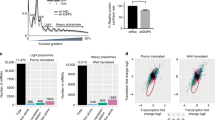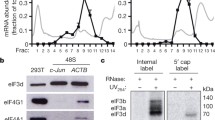Abstract
We have earlier shown that the 5′-untranslated region (5′ UTR) of the mRNA coding for activation factor of apoptotic peptidase 1 (Apaf-1) can direct translation in vivo by strictly 5′ end-dependent way even in the absence of m7G-cap. Dependence of translational efficiency on the cap availability for this mRNA turned out to be relatively low. In this study we demonstrate that this surprising phenomenon is determined the 5′-proximal part (domains I and II) of highly structured Apaf-1 5′ UTR. Remarkably, domain II by itself was able to reduce dependence of the mRNA on the cap on its transferring to a short 5′ UTR derived from a standard vector. We suggest that the low cap-dependence inherent to some cellular mRNAs may have an important physiological significance under those stress conditions when the function of cap-binding factor eIF4E is impaired.
Similar content being viewed by others
Abbreviations
- Apaf-1:
-
apoptotic peptidase activating factor 1
- CITEs:
-
cap-independent translational enhancers
- eIF:
-
eukaryotic initiation factor
- IRES:
-
internal ribosome entry site
- 5′ UTR:
-
5′-untranslated region
References
Cully, M., and Downward, J. (2009) Biochem. Soc. Trans., 37, 284–288.
Polunovsky, V. A., and Bitterman, P. B. (2006) RNA Biol., 3, 10–17.
Averous, J., and Proud, C. G. (2006) Oncogene, 25, 6423–6435.
Robert, F., and Pelletier, J. (2009) Expert Opin. Ther. Targets, 13, 1279–1293.
Silvera, D., Formenti, S. C., and Schneider, R. J. (2010) Nat. Rev. Cancer, 10, 254–266.
Proud, C. G. (2009) Biochem. Soc. Trans., 37, 227–231.
Lin, T. A., Kong, X., Haystead, T. A., Pause, A., Belsham, G., Sonenberg, N., and Lawrence, J. C., Jr. (1994) Science, 266, 653–656.
Pause, A., Belsham, G. J., Gingras, A. C., Donze, O., Lin, T. A., Lawrence, J. C., Jr., and Sonenberg, N. (1994) Nature, 371, 762–767.
Poulin, F., Gingras, A. C., Olsen, H., Chevalier, S., and Sonenberg, N. (1998) J. Biol. Chem., 273, 14002–14007.
Reiling, J. H., and Sabatini, D. M. (2006) Oncogene, 25, 6373–6383.
Morley, S. J., Coldwell, M. J., and Clemens, M. J. (2005) Cell. Death Differ., 12, 571–584.
Schafer, Z. T., and Kornbluth, S. (2006) Dev. Cell., 10, 549–561.
Coldwell, M. J., Mitchell, S. A., Stoneley, M., MacFarlane, M., and Willis, A. E. (2000) Oncogene, 19, 899–905.
Mitchell, S. A., Spriggs, K. A., Coldwell, M. J., Jackson, R. J., and Willis, A. E. (2003) Mol. Cell., 11, 757–771.
Ungureanu, N. H., Cloutier, M., Lewis, S. M., de Silva, N., Blais, J. D., Bell, J. C., and Holcik, M. (2006) J. Biol. Chem., 281, 15155–15163.
Macejak, D. G., and Sarnow, P. (1991) Nature, 353, 90–94.
Holcik, M., and Sonenberg, N. (2005) Nat. Rev. Mol. Cell. Biol., 6, 318–327.
Komar, A. A., and Hatzoglou, M. (2005) J. Biol. Chem., 280, 23425–23428.
Graber, T. E., and Holcik, M. (2007) Mol. Biosyst., 3, 825–834.
Spriggs, K. A., Stoneley, M., Bushell, M., and Willis, A. E. (2008) Biol. Cell, 100, 27–38.
Komar, A. A., and Hatzoglou, M. (2011) Cell. Cycle, 10, 229–240.
Andreev, D. E., Dmitriev, S. E., Terenin, I. M., Prassolov, V. S., Merrick, W. C., and Shatsky, I. N. (2009) Nucleic Acids Res., 37, 6135–6147.
Stoneley, M., Paulin, F. E., Le Quesne, J. P., Chappell, S. A., and Willis, A. E. (1998) Oncogene, 16, 423–428.
Dmitriev, S. E., Andreev, D. E., Ad’yanova, Z. V., Terenin, I. M., and Shatsky, I. N. (2009) Mol. Biol. (Moscow), 43, 108–113.
Barreau, C., Dutertre, S., Paillard, L., and Osborne, H. B. (2006) RNA, 12, 1790–1793.
Dmitriev, S. E., Andreev, D. E., Terenin, I. M., Olovnikov, I. A., Prassolov, V. S., Merrick, W. C., and Shatsky, I. N. (2007) Mol. Cell. Biol., 27, 4685–4697.
Vassilenko, K. S., Alekhina, O. M., Dmitriev, S. E., Shatsky, I. N., and Spirin, A. S. (2011) Nucleic Acids Res., 39, 5555–5567.
De Gregorio, E., Preiss, T., and Hentze, M. W. (1998) RNA, 4, 828–836.
Ali, I. K., McKendrick, L., Morley, S. J., and Jackson, R. J. (2001) EMBO J., 20, 4233–4242.
Gunnery, S., Maivali, U., and Mathews, M. B. (1997) J. Biol. Chem., 272, 21642–21646.
Shatsky, I. N., Dmitriev, S. E., Terenin, I. M., and Andreev, D. E. (2010) Mol. Cells, 30, 285–293.
Terenin, I. M., Andreev, D. E., Dmitriev, S. E., and Shatsky, I. N. (2012) Nucleic Acids Res., doi: 10.1093/nar/gks 1282.
Lerner, R. S., and Nicchitta, C. V. (2006) RNA, 12, 775–789.
Author information
Authors and Affiliations
Corresponding author
Additional information
Published in Russian in Biokhimiya, 2013, Vol. 78, No. 2, pp. 220–229.
Originally published in Biochemistry (Moscow) On-Line Papers in Press as Manuscript BM12-254, January 13, 2013.
Rights and permissions
About this article
Cite this article
Andreev, D.E., Dmitriev, S.E., Terenin, I.M. et al. Cap-independent translation initiation of Apaf-1 mRNA based on a scanning mechanism is determined by some features of the secondary structure of its 5′ untranslated region. Biochemistry Moscow 78, 157–165 (2013). https://doi.org/10.1134/S0006297913020041
Received:
Revised:
Published:
Issue Date:
DOI: https://doi.org/10.1134/S0006297913020041




